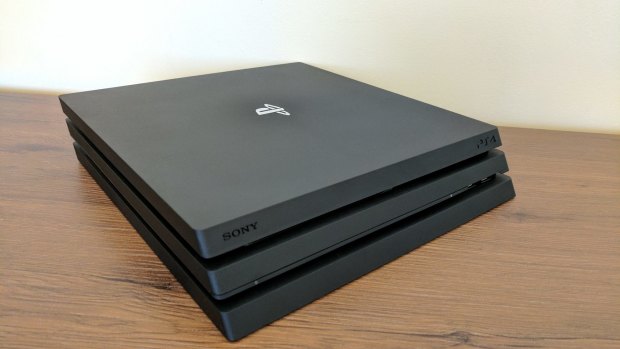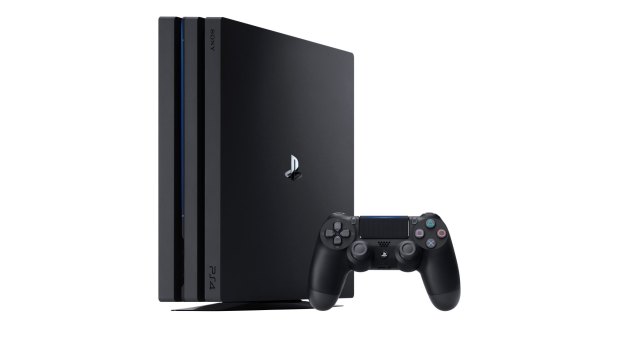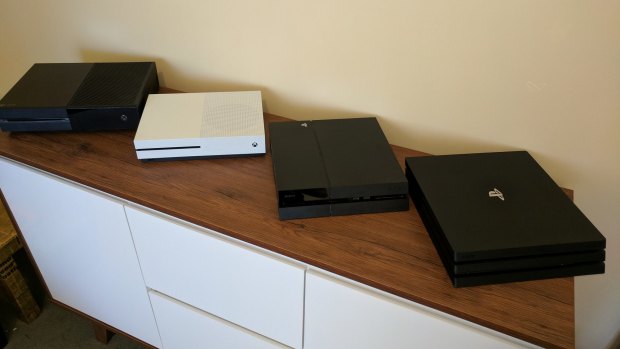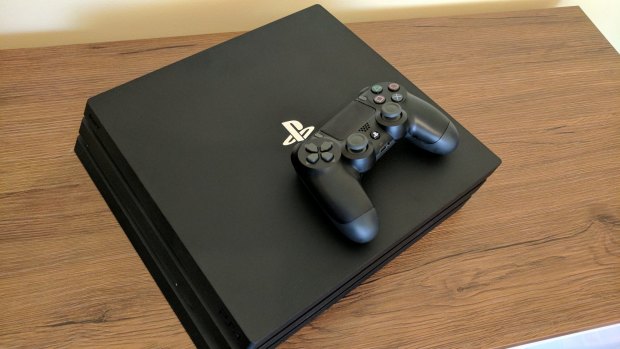This was published 8 years ago
PlayStation 4 Pro review: consoles enter the smartphone age of rolling hardware updates
By Tim Biggs
Bigger, heavier and ever-so-slightly louder than its predecessor, the PlayStation 4 Pro marks a turning point for video game home consoles as, for the first time, a significantly more powerful machine is being introduced without jumping to a new generation.
This is the most powerful games console you can get right now, much more powerful than the base PS4 or Microsoft's Xbox One, and it will likely be so until Microsoft unleashes it's secretive Project Scorpio in late 2017. At it's best, it will give players a more technically impressive experience than the other contemporary consoles can muster. Yet the fact that it plays all the same games as the standard PS4 and doesn't truly hit its stride until you connect it to a brand new 4K TV makes it a bit of a tough sell.

The PS4 Pro is a chunky console with an interesting triple parallelogram design. Credit: Tim Biggs
All existing PlayStation 4 games – whether bought physically or digitally – will work on the both the standard PS4 and PS4 Pro. All future games will too, but the promise is that they'll be elevated on Pro. Think of it as the difference between an iPhone 6 and iPhone 7. All apps work on both, and you keep your purchases when you upgrade, but this one has more grunt.
Specifically, the Pro has a higher-clocked version of the same CPU and a much more powerful graphics processor when compared to the standard. It also has an additional USB port (at the back, perfect for PlayStation VR), packs a 1TB hard drive and returns the optical audio port. Notably, the extra graphical power allows the machine to render games and streaming media at up to 4K resolution.

Twice the GPU power, bumped up CPU, same PS4 games.
It's not an automatic boost for all games, however. Developers have free rein to decide how they will use the extra power going forward, with many opting to increase the resolution, frame-rate or complexity of the visuals. This is an easy and effective route, as most developers have already built their games to PC scalability anyway, but future titles could conceivably add more complex AI, more characters on screen or any other enhancement.
Many of the games I tested give options for the player to decide how they'd like the extra processing capability to be used, which mixes some of the flexibility of PC gaming with the dependability of a console, and would make for a very interesting approach if it becomes the standard.
For example when Final Fantasy XV releases on November 29next week, players on Xbox One or the standard PS4 will experience at around 1080p and 30 frames per second, while PS4 Pro players will choose between two modes: 1080p and 60fps for a more responsive experience, or 4K and 30fps for a more cinematic one.
At launch, many previously-released games have been updated to make use of the extra horsepower. Once you hook up your PS4 and sign in, any updated games you own will download a patch to add the extra features in.

The Pro (right) is bulkier than the original PS4 and the new Xbox One S, although it's still not as big or heavy as the launch Xbox One (left).Credit: Tim Biggs
Yet, while I was pleased to see several games I already owned instantly upgraded, some improvements are subtle to the point that you wouldn't notice without seeing them side by side with the original. Some games wowed me instantly with a smoother or clearer appearance, while for others I actually had to Google to find out what had been improved. Of course, the large majority of games released prior to November 2016 have not been updated, and they play identically on either the Pro or the standard.
Since the most impactful upgrades make use of 4K resolution (and high dynamic range colour, which all versions of the PS4 can display), so you'll get best results if you own a 4K, HDR TV. Suddenly games that were rendered a little bit blurry due to the simple upscaling are crystal clear in 4K, while already-gorgeous titles like Rachet and Clank are given a new sheen with stunning colour and extra detail.

The Pro also comes with a (slightly) redesigned controller.Credit: Tim Biggs
Still, gamers with a regular 1080p (AKA Full HD) set will benefit from the Pro, too.
Improvements like frame-rate increases, better lighting and more complex graphics can be seen regardless of the type of TV used, and if a game supports resolutions higher than 1080p the Pro will render at that and then downscale to fit your screen, meaning a cleaner image than you'd get with the standard PS4, even on an older TV.
As the Pro is roughly twice as powerful as the standard, and 4K is four times the pixels of 1080p, expecting all games to be able to run natively in 4K is unreasonable (although some do, like Skyrim and The Last of Us). Developers are therefore opting for different pathways to get there, with some (for instance, Rise of the Tomb Raider) looking stunning via a cheeky method called checker-boarding that omits pixels in a way your brain won't perceive. Others (such as Titanfall 2) are going for a stable sub-4K resolution and then upscaling from there, which is still an improvement but not as marked.
Speaking of Tomb Raider, the game really exemplifies how I hope Pro games are treated in the future. The game gives players three options: play in 4K (via the aforementioned method that magically allows it to keep to 30 frames per second despite the bump in resolution), play at 1080p with a much faster frame rate or play at 1080p with all the game world's visual effects bumped up.
Hardcore PC gamers may look at all this and scoff at the Pro's claim to be a 4K gaming machine, but then that would miss the entire point of having a home console as compared to having a PC. Yes, rendering games in native 4K using a brutally powerful $1000+ graphics card in a very expensive PC is different from many of the techniques we've seen PS4 Pro games using thus far. But this is a $560 home console, and we've already seen impressive results despite the fact none of the supported games were originally conceived with the Pro in mind.
Games will still look and perform better on a high end PC, as they always will, but the Pro goes most of the way there while keeping the reliability and ease-of-use of a console. It's a solid value proposition.
It's worth noting that many skeptics have worried that a focus on 4K is over-reaching, and that some games will inevitably run worse on Pro than on the standard PS4. Videos from respected benchtesters Digital Foundry have found evidence that, in some games, running 4K mode does actually result in a less stable framerate than that of the standard PS4. The dips are minor and, try as I might, I couldn't detect any with my bare eyes, but it might be prudent to adopt a wait-and-see approach if you're thinking about replacing your PS4 with the Pro, especially if you don't have a 4K TV. PlayStation has told me it has a mandate against games running worse on Pro than the standard, so I expect issues to remain limited.
All things considered the PlayStation 4 Pro is a very impressive machine. Some will be disappointed it doesn't run everything in 4K but I think letting the developers themselves decide what's best for their games will turn out to be the best choice in the long run, and the machine will only get more attractive as more games release. Others will be disappointed the Pro does not play 4K UHD Blu-Ray discs, but I'm fine with my games consoles being for games.
At $559, the Pro is around $100 dearer than the standard, and the future-proofing alone makes it an obvious choice if you're yet to purchase a PS4. It's a stiff price for those looking to upgrade, though. If you have a 4K TV this is the only way you're going to get (some) console games looking perfectly sharp on it, so it could be worth the investment. Every one else (and let's face it, that's most of us) might be better off waiting to see what developers make of the Pro in the months to come.